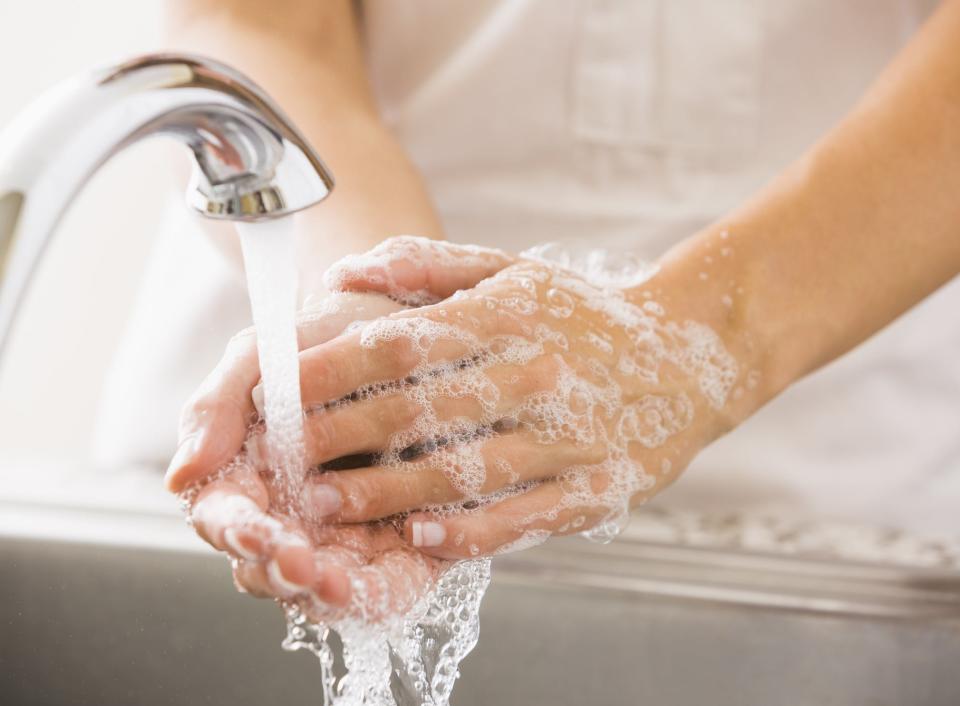You’ve Probably Been Washing Your Hands Wrong Your Whole Life
Most of us pride ourselves on being pretty clean (and we have the cabinets full of products to prove it), but we’re usually missing something. Taking your hygiene from sparkling to spotless doesn’t have to mean professional cleaners or hours of work. Here are seven quick and easy tips to help you (and your home) get five stars every time.

1. Wash your hands properly. Sorry to have to tell you, but you’ve probably been doing this wrong your whole life. In a study by the Department of Agriculture, 97 percent of people didn’t meet their standards of acceptable hand washing. So how are you supposed to do it? According to the Centers for Disease Control and Prevention (CDC), start by wetting your hands, then turn off the tap, lather the soap up nicely, and scrub all over for 20 seconds, including between fingers and thumbs and under your nails. Rinse thoroughly and air dry, or use a clean towel that’s only for your hands. No more splashing and dashing.
2. Cut your nails short. While we’re talking hands, let’s look at the part that harbors the most bacteria: your nails. It’s not that the bacteria on your nails is different from the rest of your hand; there’s just more of it. Studies have shown that nails over three millimeters long and artificial nails are more likely to be carrying potentially dangerous bacteria. It’s not all bad news, though: Wearing nail polish has been found to have no discernible effect. Keep nails natural and cut them short for optimum hygiene — and paint them if you want.
3. Replace your toothbrush every three months. Various studies have found that toothbrushes are easily contaminated with bacteria from your mouth and the environment (yes, that includes the toilet.) The American Dental Association (ADA) says that it’s unclear whether these bacteria will harm your health or your teeth, but they have a few hygiene tips anyway. Rinse the bristles carefully after each use; some studies have found that soaking the head in mouthwash after brushing prevents contamination. Keep your toothbrush uncovered and dry, as plastic cases and humid conditions can lead to more bacterial growth. Don’t share with anyone else — if you suffer from bleeding gums, there’s a chance bacteria could get directly into your bloodstream. And make your dentist proud by actually replacing your toothbrush every three months: The older your toothbrush, the more bacteria it harbors.
4. Wash your towels and bed sheets. Although most of the microbes on your towels and bed sheets come from you, and therefore aren’t harmful, there’s a good chance you’re also contaminating them with things like E. coli, fecal matter, and fungi. Bacteria thrive on the damp warmth of a never-quite-dry towel or just-slept-in bed sheets, and the latter are also a haven for dust mites and bed bugs. The best way to minimize the number of organisms you’re sharing a bed or towel with is through laundry: Ideally every two days for towels, and once a week for sheets, at the hottest temperature possible.
5. Take your shoes off. Wearing your outdoor shoes inside brings all the bacteria you’ve picked up throughout the day into your home — and it could be a lot. One study by the University of Arizona and The Rockport Company found that after two weeks of wear, 10 pairs of formerly brand-new shoes had an average of 421,000 units of bacteria on the outside, and 2,887 inside, including E. coli; pneumonia; and Serratia ficaria, which can cause infections in the respiratory tract and wounds. Nearly all of them — 90 to 99 percent — were transferred to uncontaminated tiles. Washing with cold water and laundry detergent removed 99 percent of the bacteria from the outside of the shoes, but that doesn’t help if you’ve already worn them inside. Go barefoot or wear comfy slippers instead, and tell your guests that science backs up your no-shoes-inside rule.
6. Throw out your kitchen sponge. Just like your towel, your kitchen sponge is a bacterial paradise. A 2017 study found an average of 54 billion bacterial cells per cubic centimeter. And cleaning the sponge didn’t appear to make a difference; in some cases, it actually increased the amount of bacteria. The most effective way to clean dishes is in the dishwasher, since unlike hand-washing, it can get water over 145ºF, the temperature needed to kill bacteria. If you don’t have a dishwasher, or you don’t generate a full load very often, the best option is a silicone or plastic brush — these dry out quicker than a sponge and don’t have as many crevices for the bacteria to get inside and thrive.
7. Clean your cell phone. Your cell phone goes where you go, so no wonder it’s covered in bacteria! A study of 105 phones found 101 were home to a mix of bacteria, including 17 contaminated with staph, which can cause minor and serious infections. Obviously you can’t spray your phone with bleach; instead, mix 60 percent water and 40 percent rubbing alcohol, and rub a small amount on your phone with a clean cloth. And stop taking your phone to the bathroom, especially if you’re also taking it to dinner!
Do you have a quick and easy cleaning hack? Share it with us @BritandCo.
(Photo via Getty)


